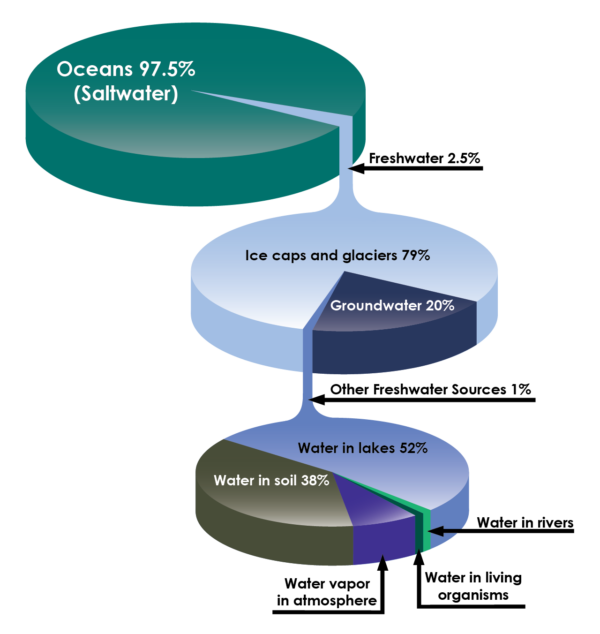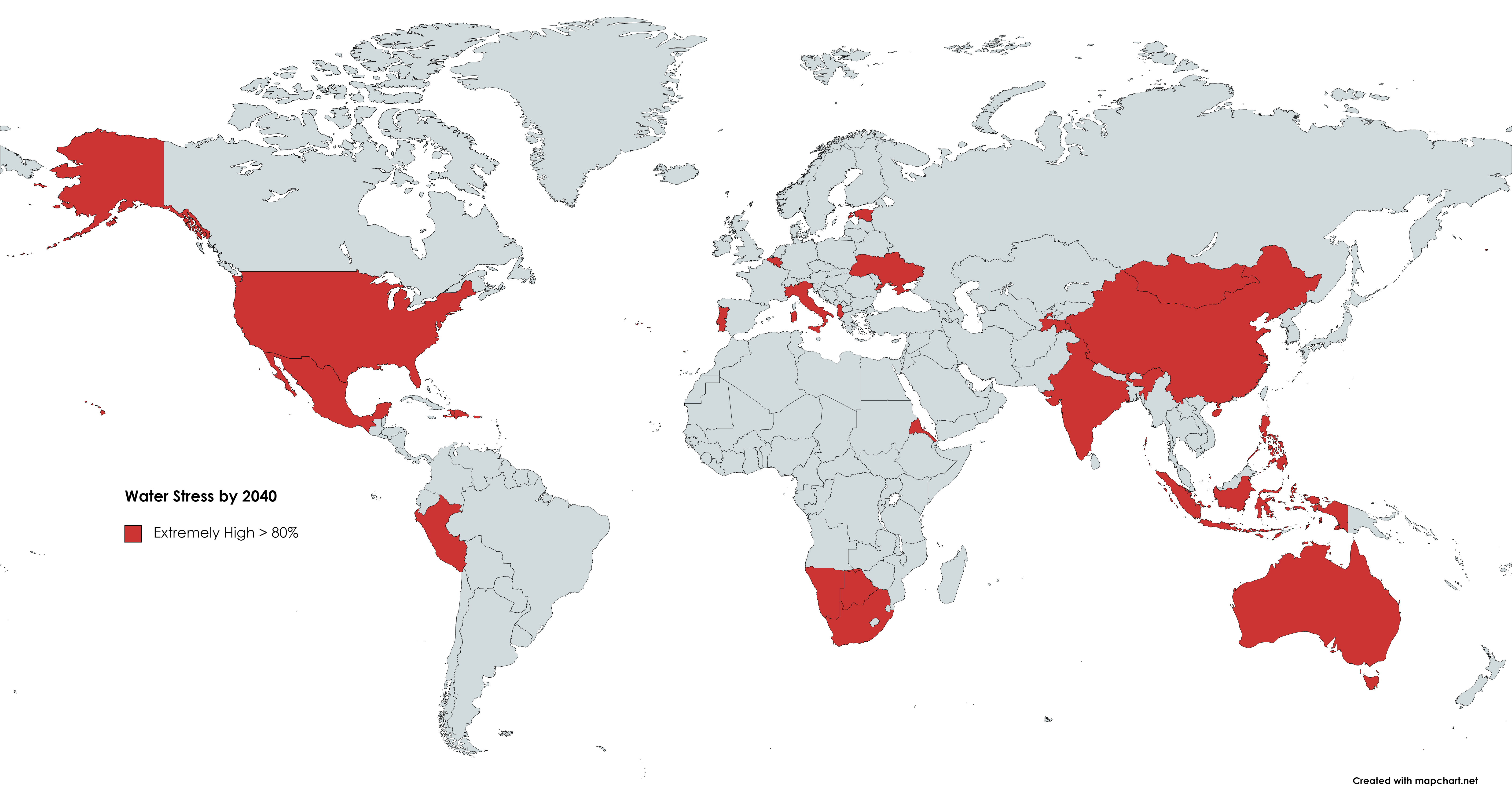Plasma Water Purification, The Future?
Freshwater scarcity is one of the major challenges that we will be facing on earth and future lunar and interplanetary missions. On earth only 2% of water on the planet is fresh water and 80% of freshwater is being menaced by global melt and climate change. [a] In low earth orbit on the ISS the chemicals, catalysts, and filters currently being used for water recycling must constantly be resupplied from Earth making it impractical for deep space missions. Plasma-based water purification is reusable and could play a key role in cross planet exploration and alleviating earth’s fresh water scarcity.[b]
 Salt Water and Freshwater Distribution on Earth, Source: NASA/Goddard Space Flight Center Scientific Visualization Studio
Salt Water and Freshwater Distribution on Earth, Source: NASA/Goddard Space Flight Center Scientific Visualization Studio
Half of the world’s population could be living in areas facing water scarcity by as early as 2025. Roughly 1 in 4 children worldwide will be living in areas of extremely high water stress.[c] 44 countries face either “extremely high” or “high” water-stress levels by 2040. At the same time, rising sea levels place a growing number of geographies, particularly in East and South-east Asia, at a higher risk of flooding, which can overwhelm sanitation systems and pollute drinkable water sources.[c]

Water reuse is a growing industry worldwide. In Kuwait 75% of wastewater is treated and 54% is reused leading the world in use per capita.[d] A total of 25% of untreated wastewater is discharged to the sea. This wastewater contains a range of pathogens, including bacteria, parasites, and viruses and causes deoxygenated dead zones in the sea, accumulation of nitrous oxide, and emissions of methane, a powerful global warming gas. [e]
Desalination
Desalination has the potential and capacity to support large sectors of a countries water needs. Its biggest challenges are energy consumption and brine discharge that can also create ocean dead zones.
In April 2021, before the drought, rivers provided 63% of Barcelona’s drinking water, wells provided 34% and desalination just 3%. Two years later desalination makes up 33% of Barcelona’s drinking water, while wells provide 23% and its shrinking rivers just 19%, according to Barcelona’s municipal water company.

Plasma water purification
Cold Plasma purification uses an electrical discharge in water to inactivate bacteria and dissociate antibiotics via advanced oxidation, UV radiation, charged particles. It is easy to integrate a non-thermal plasma treatment system into existing wastewater or desalination infrastructure.
Plasma is the fourth state of matter, formed when gas is energized to the point where its electrons break free from their atoms, resulting in a mixture of positively charged ions and negatively charged electrons. This ionized gas has unique properties, including high energy and reactive species, making it an excellent candidate for water purification processes.
Plasma water purification involves using the high-energy and reactive nature of plasma to eliminate contaminants and microorganisms from water sources. The process can be broken down into several steps:
Ionization: A gas is introduced into a chamber and subjected to energy, causing the gas to become plasma.
Reactive species formation: Plasma generates various reactive species, such as hydroxyl radicals (OH), ozone (O3), and hydrogen peroxide (H2O2). These species possess strong oxidizing properties, capable of breaking down and destroying organic pollutants.
Contaminant removal: Contaminated water is passed through the plasma chamber, and the reactive species react with and neutralize the contaminants, transforming them into harmless byproducts.
Plasma purification at the untreated wastewater discharge stage would lessen the environmental impacts and reduce the three largest factors that lead to antimicrobial risks: antibiotics, antibiotic-resistant bacteria and antibiotic-resistant genes in industrial wastewater.
It is also an emerging technology for desalination and solves for toxic brine discharge. Direct plasma discharge on saline water or contaminated water has been performed to obtain water with low salinity or contaminant levels. This new plasma approach may help to address the problems of the energy intensive brine concentration process and provide a solution to effectively use the brines to generate high value salt compounds. [f]
Deep Space
Plasma water purifications many advantages over chemical systems make it an ideal candidate for cislunar missions and future long term missions to Mars and beyond.
High Efficiency: Plasma-based water purification systems have shown excellent efficiency in removing a wide range of contaminants, including bacteria, viruses, organic compounds, and heavy metals. This ensures a reliable supply of clean water for astronauts, reducing health risks and increasing mission success.
Compact and Lightweight: Plasma purification systems can be designed to be compact and lightweight, a critical factor in space missions where every ounce matters. Compact systems allow for more space to be allocated to other essential equipment and supplies.
Continuous Operation: Plasma water purification systems can be operated continuously, providing a consistent supply of purified water. This is vital for long-duration space missions where access to fresh water is limited.
No Chemical Byproducts: Unlike traditional water purification methods that may produce chemical byproducts harmful to the environment, plasma-based systems generate only harmless gases, making them eco-friendly.
References
Laboratory experimental comparisons for on-board applicability

